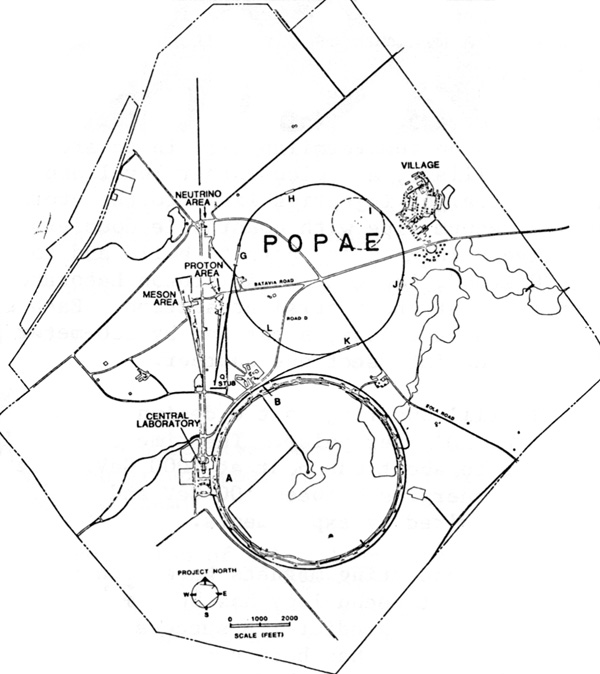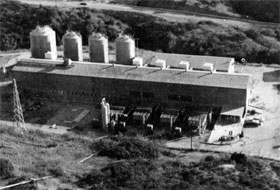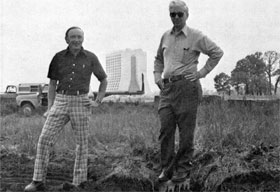POPAE Colliding Beam Study Announced
A design study for a 1000 GeV on 1000 GeV colliding proton beam storage ring facility to be located at Fermilab has recently been completed. The design study was the result of a collaboration between Argonne National Laboratory and Fermilab, which began in the fall of 1975 under the direction of Robert Diebold of Argonne.
The construction of such a colliding beam facility (denoted by the acronym POPAE: Protons On Protons And Electrons) at Fermilab would take advantage of the substantial national investment in the facilities of the Laboratory. The present accelerator is itself a uniquely suitable device for filling storage rings with high energy protons, and in a few years the Energy Saver/Doubler will increase the available proton energy to 1000 GeV. The research capabilities of Fermilab would be extended in a natural and complementary way by the addition of the proposed proton storage rings.
High energy storage rings are being considered at other laboratories. Brookhaven National Laboratory has proposed a 200 GeV on 200 GeV proton-proton colliding beam facility, Isabelle, which would accelerate the protons from a 30 GeV injection energy. CERN has studied the possibilities of 400 GeV on 400 GeV storage rings, which like POPAE would receive protons from an accelerator at the desired energy.
At present, the ISR at CERN is the world's only proton-proton colliding beam machine. This facility gave an enormous increase in useful energy over that previously available, up to an energy equivalent to that of a 2000 GeV fixed-target accelerator. However, this energy has since been approached by Fermilab.
The interest in colliding beams at Fermilab goes back to the site-selection days when one of the site-selection criteria was that space be available to accommodate future storage rings. Indeed, the State of Illinois went to great expense to provide this capacity in the land purchase.
For further energy increases, however, colliding beams quickly outstrip the useful energy of fixed target machines, even those that might conceivably be built as part of a World Collaboration. In terms of equivalent fixed-target machine energy, POPAE would provide a factor of 1000 increase over the ISR. An equivalent fixed target machine would circle the North American Continent. The phenomena found in the energy range spanned by the previous factor of 1000, going from 2 GeV up to 2000 GeV at the ISR, have profoundly changed our understanding of nature and indeed encompasses the whole history of elementary particle physics. There are some ideas of what may be found as the frontier advances beyond present energies, but considering the surprises in the previous factor of 1000 it seems probable that these expectations will pale beside the phenomena which will actually be discovered.
In the fall of 1975, Robert Sachs, the Director of Argonne National Laboratory, suggested that Argonne and Fermilab collaborate in a joint design study for POPAE. This suggestion was welcomed by Robert Wilson, the Fermilab Director, and since that time a joint Argonne-Fermilab team has been actively developing the detailed conceptual design. Although the present design does not include detailed provisions for electron-proton collisions, these provisions can be incorporated by the later addition of an electron storage ring with a minimum of disruption and cost.
The design study proposes that the two rings of POPAE be housed in a common tunnel of circumference 5.5 km (slightly smaller than the 6.3 km of the Main Ring). The machine would be located on the Fermilab site in an area bounded by the Main Ring, the Proton Laboratory, and the Village, a region rather level and free of obstructions. This location results in nearly straight injection lines to the storage rings. These lines would consist mainly of buried vacuum pipe with quadrupole doublets every 150 meters for focusing, and would be relatively inexpensive both to build and to operate. One of these lines would originate at the "Q stub," located in the Proton Laboratory beam line, and the other from a new extraction point at the B straight section. Each storage ring would be composed of six 720-meter long curved sections, separated by 200-meter long straight sections where the beams are focused and intersect one another.
To fill one ring to the design value of 5 A would take 6 x 1014 protons, 66 accelerator pulses at 1013 per pulse. The time to do this would range from a few minutes at low energies to about one hour at 1000 GeV. Each ring would be able to store high beam currents at energies between 100 GeV and 1000 GeV, and unequal-energy operation would be possible as required by experiments.
Superconducting magnets have been specified for POPAE in the design study. Superconducting magnet technology has been moving ahead in the past few years to the point where one can confidently predict its successful application to high energy storage rings. A field of 60 kG at 1000 GeV has been used in the design study. This field is somewhat higher than the 40 to 45 kG design of the Energy Saver/Doubler. A 60-kG dipole magnet of a design rather similar to that considered for POPAE has been built and operated by H. Desportes and his colleagues at Saclay, and this field strength would appear to be a reasonable goal for the next step in accelerator technology.
The design study estimates the total construction cost of the facility, including engineering, architectural costs and contingency to be $245 million in 1976 dollars.





